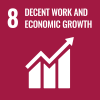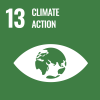Somali Region, 17 October 2022 – Abdikader never expected the severe drought gripping Ethiopia would affect his clothing and sewing business. He was wrong.
“When people think of drought, they mostly think of dry lands affected farmers, and dead animals,” he said. “While this is indeed the reality and it is devastating, we often forget about people like us, business owners who are also supporting many of our employees’ families.”
The manager of a clothing and sewing shop owned by nine other people, he is one of the many entrepreneurs whose businesses have been heavily impacted by drought ravaging Ethiopia’s Somali Region.

Some of the colorful garments being sold at the clothing shop. Photo: IOM/Kaye Viray
“This is one of the worst droughts we’ve seen. While we’re not reliant on farming, our consumers are. With them not earning enough, this means their purchasing capacity is limited as well,” said Abdikader, who is worried for the future of his business, as many of his clients have left the region.
The men work in the shop while the female employees are allowed to work from their homes so they can continue to look after their children.

Abdikader’s clothing and sewing workshop in Ethiopia’s Somali Region. Photo: IOM/Kaye Viray
Ethiopia is experiencing the worst drought it has seen in 40 years following four consecutive failed rainy seasons. Nearly 2 million people are displaced in the vast, drought-affected areas, one-third as a direct consequence of the lack of rainfall. The most affected regions – Somalia, Oromia and Afar – constitute an estimated three quarters of the country’s total land area.
Many people traditionally employed by pastoral and agropastoral activities are willing to seek new types of work, but the limited skill base, minimal market opportunities and poor access to assets and financing limit their options.
Support and revitalize small businesses
The International Organization for Migration's (IOM) Enterprise Development Fund (EDF) is being piloted in Ethiopia’s Somali Region to support the revitalization of drought-impacted small- and medium-size enterprises (SMEs).
IOM’s flagship EDF model was launched in Iraq and has since been piloted in Lebanon and Pakistan. It begins with a labour market assessment and can be designed to fit the specific context and meet different objectives.
“Under EDF, SMEs and social enterprises receive grant funding provided by IOM following a rigorous application and due diligence process,” said David Coomber, IOM Ethiopia’s Durable Solutions Initiative Programme Manager.
“The overall objective is job creation within sustainable businesses that were successful before the drought, to help revitalize the private sector and create an environment favourable to solutions for internally displaced persons (IDPs).”

The clothing shop employs men, who are working on site, and women, who are working from their homes. Photo: IOM/Kaye Viray
The chosen enterprise receives between USD 2,000 and USD 6,000. This grant prioritizes youth- and women-owned businesses that have been affected by the drought and can support job creation for populations at risk of irregular migration and displacement due to the drought.
“We are looking forward to using this support to grow our team, hire more women, and to also employ drought-affected farmers so they will have an alternative source of income during these trying times,” Abdikader said.
The business owners will contribute to livelihood diversification by employing former pastoralists like many of their existing employees.

Some of the employees of the drought-affected small enterprise supported by IOM outside their shop in Somali Region, Ethiopia. Photo: IOM/Kaye Viray
IOM’s Enterprise Development Fund (EDF) in Ethiopia is funded by the Swiss Agency for Development and Cooperation (SDC).
This story was written by Kaye Viray, Media and Communications Officer, IOM Ethiopia.



